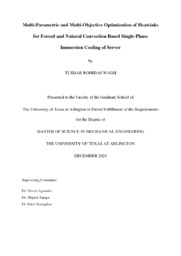
ATTENTION: The works hosted here are being migrated to a new repository that will consolidate resources, improve discoverability, and better show UTA's research impact on the global community. We will update authors as the migration progresses. Please see MavMatrix for more information.
Show simple item record
| dc.contributor.advisor | Agonafer, Dereje | |
| dc.contributor.advisor | Nomura, Seiichi | |
| dc.creator | Wagh, Tushar Rohidas | |
| dc.date.accessioned | 2023-06-28T15:17:31Z | |
| dc.date.available | 2023-06-28T15:17:31Z | |
| dc.date.created | 2021-12 | |
| dc.date.issued | 2021-12-21 | |
| dc.date.submitted | December 2021 | |
| dc.identifier.uri | http://hdl.handle.net/10106/31376 | |
| dc.description.abstract | An increase in utility of internet-based services, cloud computing and greater performance demands due to rising AI and ML applications have led to a steep growth in GPU and CPU thermal design power. Efficient thermal management of these processors has become a bottleneck in performance enhancement and corresponding power densification of these components. Furthermore, increased pressure on data center owners to reduce power demands and move towards green computing has exacerbated the data center cooling challenges. Single-phase immersion cooling allows data center owners to not only dissipate the increasing heat fluxes efficiently but can also potentially improve equipment reliability as the component are no longer exposed to air, humidity, and airborne contaminants. As a part of thermal design considerations when moving from air to immersion cooling, using optimized heat sinks designed for immersion systems plays a key role in obtaining optimal thermal performance from the CPU or GPU components. An in-depth study of designing such an optimized heat sink is addressed in this investigation. A baseline heat sink solution for an air-cooled Open Compute server was numerically optimized using multi-parametric and multi-objective optimizations. The thermal resistance of the heat sink and pumping power of the system were used as objective functions to obtain a heat sink design by tandem optimization of the fin parameters using optiSLang. The optimizations were carried out under both forced and natural convection flow regimes. Also, a comparison of the difference in optimized geometry of the heat sink was carried out for aluminum and copper as fin material. The final optimized heat sinks were used to gauge the percentage improvement in thermal performance and reduction in pumping power as compared to the baseline simulations that use an air-cooled heat sink. | |
| dc.format.mimetype | application/pdf | |
| dc.language.iso | en_US | |
| dc.subject | Single-phase immersion cooling | |
| dc.subject | optiSLang | |
| dc.title | Multi-Parametric and Multi-Objective Optimization of Heatsinks for Forced and Natural Convection Based Single-Phase Immersion Cooling of Server | |
| dc.type | Thesis | |
| dc.date.updated | 2023-06-28T15:17:31Z | |
| thesis.degree.department | Mechanical and Aerospace Engineering | |
| thesis.degree.grantor | The University of Texas at Arlington | |
| thesis.degree.level | Masters | |
| thesis.degree.name | Master of Science in Mechanical Engineering | |
| dc.type.material | text | |
| dc.creator.orcid | 0000-0003-4860-1473 | |
Files in this item
- Name:
- WAGH-THESIS-2021.pdf
- Size:
- 4.315Mb
- Format:
- PDF
This item appears in the following Collection(s)
Show simple item record


